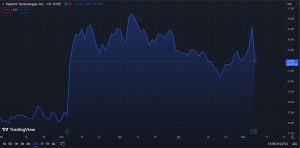Navigating The Chinese Market: The Hurdles Faced By BMW, Porsche, And Other Auto Brands

Table of Contents
Intense Competition and Market Saturation
The Chinese automotive market is fiercely competitive, characterized by rapid growth from domestic brands and significant market saturation.
Domestic Brands' Rise
Chinese automakers, such as BYD, Nio, and Xpeng, are rapidly gaining market share, posing a significant challenge to established foreign brands. These companies benefit from substantial government support and are leveraging technological advancements to offer competitive, often superior, products.
- BYD's success: BYD's Blade Battery technology and range of electric vehicles have disrupted the market, offering compelling alternatives to established brands.
- Nio's innovative approach: Nio’s battery swap technology and focus on premium EVs have carved a niche in the competitive market.
- Xpeng's intelligent features: Xpeng’s focus on advanced driver-assistance systems (ADAS) and intelligent features appeals to tech-savvy Chinese consumers.
- Government subsidies and initiatives further bolster the competitiveness of domestic brands, making it challenging for foreign automakers to compete on price alone.
Price Wars and Pressure on Profit Margins
The intense competition has ignited price wars, impacting profitability for both domestic and foreign brands. This pressure necessitates a focus on value propositions that extend beyond mere price.
- Price cuts by established brands like BMW and Mercedes-Benz reflect the competitive pressure.
- The need to offer innovative features, superior quality, and strong brand building to justify premium pricing.
- Maintaining profitability requires a well-defined value proposition emphasizing quality, performance, and brand prestige.
Regulatory Hurdles and Compliance
Operating in China involves navigating a complex regulatory landscape. Compliance is crucial, but challenging, demanding significant investments and expertise.
Navigating Complex Regulations
Chinese automotive regulations are intricate, encompassing emission standards, safety requirements, and import/export procedures. Non-compliance can lead to hefty fines and market exclusion.
- Stringent emission standards require significant investment in research and development for cleaner vehicle technologies.
- Complex import/export procedures and tariffs add to the operational costs.
- Navigating the regulatory landscape often necessitates establishing strong local partnerships with firms that possess deep understanding of these regulations.
Data Privacy and Cybersecurity Concerns
Data privacy and cybersecurity are paramount in China. Foreign automakers must implement robust measures to comply with the increasingly stringent regulations.
- The Chinese government's emphasis on data localization presents significant challenges for foreign companies.
- Data breaches can have severe reputational and financial consequences.
- Investing in strong cybersecurity infrastructure and complying with Chinese data privacy laws is non-negotiable.
Evolving Consumer Preferences and Brand Perception
Chinese consumers are sophisticated and their preferences are rapidly evolving, demanding a tailored approach from foreign automakers.
Shifting Consumer Demands
The Chinese automotive market exhibits a growing demand for electric vehicles (EVs), advanced technology features, and personalized customer experiences.
- Rapid growth in EV adoption rates in China, driven by government incentives and environmental awareness.
- Chinese consumers highly value advanced technology features like ADAS and connectivity.
- Digital marketing and personalized customer experiences are crucial to engage this tech-savvy consumer segment.
Building Brand Trust and Local Relevance
Building brand trust and adapting marketing strategies are essential for success. Localization efforts are key to resonating with Chinese consumers.
- Tailoring marketing campaigns to appeal to the specific preferences and cultural nuances of the Chinese market.
- Investment in local research and development to adapt products and services.
- Building relationships with key influencers and local partners to enhance brand credibility.
Supply Chain Disruptions and Logistics Challenges
Global supply chain disruptions and logistical complexities present significant challenges for automakers operating in China.
Global Supply Chain Issues
Global supply chain disruptions impact the availability of parts and components, potentially hindering production and sales.
- The impact of geopolitical factors and global pandemics on the timely delivery of parts and materials.
- The need for diversification of supply chains to mitigate risks.
- Investing in robust inventory management strategies and strengthening relationships with suppliers.
Logistics and Infrastructure
Efficient logistics and distribution are essential, but China's vast and diverse market presents unique challenges.
- Navigating the complex transportation infrastructure and addressing related logistical bottlenecks.
- Optimizing warehousing and distribution networks to ensure timely delivery across the country.
- Efficient customs procedures and compliance with import/export regulations are critical.
Conclusion
Successfully navigating the Chinese market requires overcoming significant hurdles: intense competition, complex regulations, shifting consumer preferences, and supply chain disruptions. Key takeaways emphasize the importance of strategic planning, adaptability, local partnerships, and a thorough understanding of the market's nuances. To master the Chinese market, automakers must invest in local R&D, adapt their products and marketing strategies, build strong relationships with local stakeholders, and ensure robust supply chain resilience. Unlocking the potential of the Chinese market demands a proactive and comprehensive approach. Are you ready to take on the challenge and successfully navigate the Chinese market?

Featured Posts
-
 Frantsiya Polsha Podpisanie Vazhnogo Dogovora Zayavlenie Unian
May 10, 2025
Frantsiya Polsha Podpisanie Vazhnogo Dogovora Zayavlenie Unian
May 10, 2025 -
 Dijon 2500 M De Vignes Plantes Aux Valendons
May 10, 2025
Dijon 2500 M De Vignes Plantes Aux Valendons
May 10, 2025 -
 Money Talks Fox News Hosts Spar Over Trump Tariffs And Economic Impact
May 10, 2025
Money Talks Fox News Hosts Spar Over Trump Tariffs And Economic Impact
May 10, 2025 -
 Is A 40 Return On Palantir Stock By 2025 Possible
May 10, 2025
Is A 40 Return On Palantir Stock By 2025 Possible
May 10, 2025 -
 Sensex Surges 1 400 Points Nifty Above 23 800 Top 5 Reasons For Todays Market Rally
May 10, 2025
Sensex Surges 1 400 Points Nifty Above 23 800 Top 5 Reasons For Todays Market Rally
May 10, 2025
